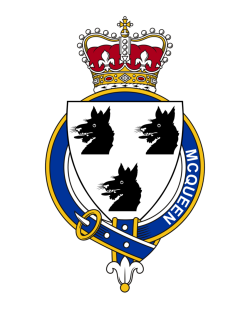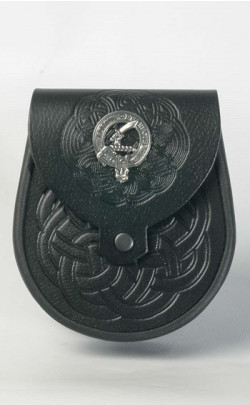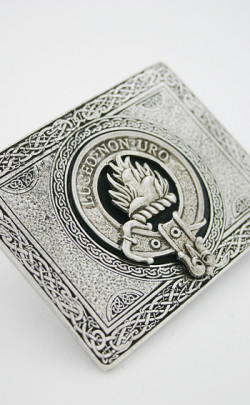
Clan MacQueen
BY THE PROVIDENCE OF GOD
Irish History
of Sweeney Family
High Kings
Although it is no easy task to entangle the strands that contribute to the complex but colourful genealogy of proud bearers of the name of Sweeney, it is a rewarding experience when it is revealed how their Celtic blood is infused with that of ancient warrior kings.
The Gaelic-Irish form of the name is MacSuibhne, indica-ting ‘son of Suibhne’, while ‘suibhne’ indicates ‘well-disposed’ or ‘pleasant.’ The original Suibhne, or Suibne, from whom the Sweeneys are considered to have taken their name, was an early seventh century Ard Rí, or High King of Ireland, who was known as Suibhne Menn, or ‘Sweeney the Renowned.’
But the Sweeney descent from Irish royalty goes back much further than Sweeney the Renowned – to no less a figure than Niall Noíghiallach, better known to posterity as the great warrior king Niall of the Nine Hostages.
The dramatic life and times of this ancestor of the Sweeneys are steeped in stirring Celtic myth and legend.
The youngest son of Eochaidh Mugmedon, King of the province of Connacht, his mother died in childbirth and he was brought up by his evil stepmother Mongfhinn who was determined that he should die.
She accordingly abandoned him naked on the Hill of Tara, inauguration site of the Ard Rí, but he was found by a wandering bard and taken back to his father.
One legend is that Mongfhinn sent Niall and his four brothers – Brian, Fiachra, Ailill, and Fergus – to a renowned prophet who was also a blacksmith to determine which of them would succeed their father as Ard Rí.
The blacksmith, known as Sitchin, set the lads a task by deliberately setting fire to his forge. Niall’s brothers ran in and came out carrying the spearheads, fuel, hammers, and barrels of beer that they had rescued, but Niall staggered out clutching the heavy anvil so vital to the blacksmith’s trade.
By this deed, Sitchin prophesied that Niall would be the one who would take on the glorious mantle of kingship.
Another prophetic incident occurred one day while Niall and his brothers were engaged in the hunt.
Thirsty from their efforts they encountered an ugly old woman who offered them water – but only in return for a kiss.
Three of the lads, no doubt repelled by her green teeth and scaly skin, refused. Fiachra pecked her lightly on the cheek and, by this act, she prophesied that he would one day reign at Tara – but only briefly.
The bold Niall, however, kissed her fully on the lips. The hag then demanded that he should now have full sexual intercourse with her and, undaunted, he did so.
Through this action she was suddenly transformed into a stunningly beautiful young woman known as Flaithius, or Royalty, who predicted that he would become the greatest High King of Ireland.
His stepmother Mongfhinn later tried to poison him, but accidentally took the deadly potion herself and died.
This legend relates to what was known as the Festival of Mongfhinn, or Feis na Samhan (the Feast of Samhain), because it was on the evening of October 31, on Samhain’s Eve, that the poisoning incident is said to have taken place.
It was believed for centuries in Ireland that, on Samhain Eve, Mongfhinn’s warped and wicked spirit would roam the land in hungry search of children’s souls.
The Festival, or Feast, of Samhain, is today better known as Halloween.
Niall became Ard Rí in 379 A.D. and embarked on the series of military campaigns and other daring adventures that would subsequently earn him the title of Niall of the Nine Hostages.
The nine countries and territories into which he raided and took hostages for ransom were the four Irish provinces of Munster, Leinster, Connacht and Ulster, Britain and the territories of the Saxons, Morini, Picts, and Dalriads.
Niall’s most famous hostage was a young lad known as Succat, son of Calpernius, a Romano-Briton who lived in the area of present day Milford Haven, on the Welsh coast.
Later known as Patricius, or Patrick, he became renowned as Ireland’s patron saint, St. Patrick, responsible for bringing the light of Christianity to the island in the early years of the fifth century A.D.
Raiding in Gaul, in the area of Boulogne-sur-mer in present day France, Niall was ambushed and killed by one of his treacherous subjects in 405 A.D.
But his legacy survived through the royal dynasties and clans founded by his brothers and sons – including his son Eoghain, who laid the foundations of the clan confederation known as the Cineal Eoghain.
Part of the northern Uí Neill, these clans included the Sweeneys, MacLachlans, MacEwens, O’Neills and others.
The main territory of the Sweeneys was in present day Co. Donegal, in the northern province of Ulster.
But a dispute within the family ranks in the early eleventh century, over the rights to the kingship of the Donegal area known as Aileach, finally led to one of the contenders, Anrathan, quitting Irish shores along with a number of followers.
Crossing the North Channel, they fetched up in present day Argyllshire, in the west of Scotland, and eventually amassed rich territories.
The main seat of these expatriate Irish Sweeneys became Knapdale, where they built Castle Sween and whose brooding ruins can be seen to this day.
By the late thirteenth and early fourteenth centuries Scotland had become a battleground because of rival claimants to the throne and the imperialist ambitions of England’s King Edward I and, later, his son Edward II.
One of the foremost claimants to the Scottish Crown was Robert the Bruce, but he was not universally supported, and the Sweeneys were among those who opposed his ambitions. Bruce managed to seize the Crown and later consolidated his kingship after inflicting a celebrated defeat on an English army at the battle of Bannockburn, in the summer of 1314.
Not unexpectedly, the Sweeneys found themselves dispossessed as Bruce distributed their Argyllshire lands among those who had remained loyal to him.
The Sweeney clan chieftain in Scotland at this time was Murchadh Mear Suibhne – with ‘Mear’ rather alarmingly denoting ‘Mad’. But, mad or not, Murchadh took the sensible step of accepting the blow to the Sweeney fortunes and literally turning his back on Scotland.
He and the large bulk of the clan accordingly set back off across the North Channel to resettle in the original Sweeney homeland of Donegal, rejoining their kinsfolk who had remained there.
But some Sweeneys chose to remain in Scotland, later becoming identified there with the proud clan of MacQueen – and that is why ‘MacQueen’ is recognised as one of the many spelling variations of the Sweeney name.
The main base of the Sweeneys now became established at Fanad, on a bank of the estuary of Lough Swilly.
It was from here that they flourished to such an extent that they gradually branched off into three important and powerful septs that were destined to play an important role throughout the future course of Ireland’s turbulent history.
Clan of the Battle-Axe
The three main septs of the Sweeneys were those of MacSuibhne Fanad, MacSuibhne Banagh and MacSuibhne na d’Tuatha – and this proliferation of septs explains why there are different crests on the family coat of arms.
But a main feature of all the coats of arms is a boar and a battle-axe, and the reason for the recurrent motif of the battle-axe is that the Sweeneys were so renowned for their skilful use of this deadly weapon that they were known as ‘The Clan of the Battle-Axe.’
The sept of MacSuibhne Fanad, known as ‘the chiefly family of Doe’, is recognised as the senior line of the family, and it was at Fanad in Donegal that they built an imposing castle at Rathmullan in addition to a number of other castles that included that of Rahain, or Rahan.
The MacSuibhne Banagh sept sprang from the loins of Dubhgall, a grandson of Murchadh ‘the Mad’, while a branch of the MacSuibhne na d’Tuath sept relocated much further southwards from Donegal to the area of present day Co. Cork.
More than two centuries before these septs had become established, what proved to be the death knell of the ancient Gaelic-Irish way of life of clans such as the Sweeneys had been sounded.
This was in the form of the Norman invasion of Ireland and the subsequent consolidation of the power of the English Crown.
By 1175, English dominion over the island had been ratified through the Treaty of Windsor, under the terms of which Irish chieftains were only allowed to rule territory unoccupied by the Normans in the role of a vassal of the English monarch.
But the powerful Norman barons, not content with the land they already held, began to ruthlessly encroach on other lands as further hordes of land-hungry Anglo-Normans also descended on the island.
The Anglo-Norman family of de Burgh, or Burke, came to hold sway as Earls of Ulster, and The Annals of the Four Masters record how Murragh MacSweeney was thrown into prison by them – and it was here that he died in 1267.
The Annals also record the death in 1524 of Niall Mór MacSweeney, chief of the Branagh sept, and how he had been renowned not only for his leadership, prowess in battle and heroism, but also for his wisdom and generosity.
He was buried at Ballysaggart, at St. John’s Point, but his magnificent headstone was later removed to St. Mary’s Church in Killybegs, overlooking Donegal Bay, where it can be admired today.
Stoking the flames of the frequent rebellions that periodically erupted in Ireland against the English Crown was its policy of settling or ‘planting’ loyal Protestants on Irish land.
This policy had started during the reign from 1491 to 1547 of Henry VIII, whose Reformation effectively out-lawed the established Roman Catholic faith throughout his dominions.
This settlement of loyal Protestants in Ireland continued throughout the subsequent reigns of Elizabeth I, James I (James VI of Scotland), and Charles I.
For many native Irish, any enemy of England was a friend of theirs, and in the late sixteenth century one of their greatest allies was England’s deadliest foe – Spain.
A 130-strong Spanish fleet, intent on the invasion of the England of Queen Elizabeth I, was scattered in heavy storms after its defeat at the battle of Gravelines in the autumn of 1588, and many vessels were driven towards the west coast of Ireland.
This caused alarm on the part of the English authorities on the island, who feared, not without justification, that the disaffected native Irish would rally to their rescue.
William Fitzwilliam, Lord Deputy of Ireland, even sanctioned the use of torture against survivors, while also ordering that anyone who came to their aid would be declared traitors.
At least 24 Spanish vessels were wrecked on the Irish coastline – from Co. Antrim in the north of the island to Co. Kerry in the south.
One of the ships was La Trinidad Valencera, which had already taken on survivors of the shipwrecked Barca de Amburgo.
Grossly overladen and listing in heavy seas, the order was given to abandon ship as she lay in Glenagivney Bay, in Co. Donegal.
Up to 560 soaked and exhausted survivors managed to struggle ashore, but were intercepted by a heavily armed body of troops.
Trusting to the mercy of the authorities, they had no sooner surrendered their arms when the Spanish officers and noblemen were separated from the group and 300 of the ordinary seamen massacred on the spot.
About 150 survivors managed to flee the scene of carnage and, intercepted by sympathetic native Irish who included Eoghan Óg MacSweeney, the Chief of Doe, were given refuge until their escape from the island was arranged.
Rebellion erupted on the island in 1594 against the increasingly harsh treatment of the native Irish and at its forefront was the O’Donnell chieftain Aodh Rua ÓDomhmaill, better known to posterity as Red Hugh O’Donnell.
In what became known as the Cogadh na Naoi mBliama, or the Nine Years War, Red Hugh and his determined allies, who included Eoghan Óg MacSweeney’s eldest son, also known as Eoghan, set the island ablaze in a vicious campaign of guerrilla warfare.
A whirlwind of devastation was wreaked on English settlements and garrisons in a daring series of lightning raids while, in 1596, allied with the forces of Hugh O’Neill, Earl of Tyrone, a defeat on an English army was inflicted at the battle of Clontibert.
This was followed by a significant victory for the rebels nearly two years later at the battle of Yellow Ford.
But the most significant defeat inflicted on the English forces during the Nine Years War came at the battle of Curlew Pass, fought on August 15th, 1599, near Boyle, Co. Roscommon, in the northwest of the island.
With Eoghan Óg MacSweeney in command of the rebel vanguard, the rebels ambushed an English force under the command of Sir Conyers Clifford at a pass through the imposing Curlew Mountains and routed them.
The English lost at least 500 men, including Clifford, whose head was cut off and triumphantly given to Red Hugh.
As English control over Ireland teetered on the brink of collapse, thousands more troops were hastily despatched and, in the face of the overwhelming odds against them, Red Hugh and the Earl of Tyrone sought help from Spain.
A well-equipped Spanish army under General del Aquila landed at Kinsale in December of 1601, but was forced into surrender only a few weeks later, in January of 1602.
It was Eoghan Óg’s kinsman, Sir Miles MacSweeney, who fought in the bitter rearguard action in the rebel retreat from Kinsale.
Resistance continued until 1603, but proved abortive and Red Hugh O’Donnell had already been forced to flee to Spain.
Four years later, in September of 1607 and in what is known as The Flight of the Earls, Hugh O’Neill, 2nd Earl of Tyrone and Rory O’Donnell, 1st Earl of Tyrconnel, sailed into foreign exile from the village of Rathmullan, on the shore of Lough Swilly, in the Sweeney homeland of Co. Donegal, accompanied by ninety loyal followers.
But Eoghan Óg MacSweeney was not among their number.
He had been captured and imprisoned two years earlier and told that his life would be spared if he revealed what he knew of Rory O’Donnell’s activities.
Opting for death rather than the betrayal of O’Donnell, he was executed in Lifford Castle in May of 1605.
Sweeneys were also at the heart of subsequent eruptions of warfare that devastated the island and further eroded their ancient Gaelic-Irish way of life.
The final nail in their coffin, and that of other clans, came in the aftermath of what is known in Ireland as Cogadh an Dá Rí, or The War of the Two Kings.
Also known as the Williamite War in Ireland, it was ignited when the Stuart monarch James II, under threat from powerful factions who feared a return to the dominance of Roman Catholicism under his rule, fled into French exile in 1688.
The Protestant William of Orange and his wife Mary were invited to take up the throne – but James had significant Catholic support in Ireland.
These supporters were known as Jacobites, and among them were Donough Óge MacSweeney, the 13th chief of the clan, and his uncle Edmund MacSweeney.
James, with the support of troops and money supplied by Louis XIV of France, had landed at Kinsale in March of 1689 and joined forces with his Irish supporters.
A series of military encounters followed, culminating in James’s defeat by an army commanded by William at the battle of the Boyne on July 12, 1690.
James fled again into French exile and, after another series of military encounters, Jacobite defeat was finally ratified through the Treaty of Limerick.
Prominent on the ‘Most Wanted’ list of particularly recalcitrant Jacobites were Donough Óge MacSweeney and his uncle.
Both men reluctantly left their native land for France, where they died in lonely exile.
Family History Mini Book
We hope you enjoyed reading this excerpt from this mini book on the Irish history of the MacQueen family.
You can buy the full book for only121 Clan MacQueen
Tartan Products
The Crests
of Clan MacQueen

































































